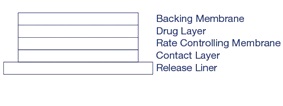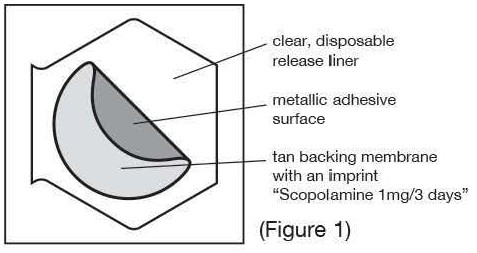Transderm Scop
Generic name: scopolamine transdermal
Drug classes: Anticholinergic antiemetics, Anticholinergics / antispasmodics
Medically reviewed by A Ras MD.
What is Transderm Scop?
Transderm Scop is a prescription medicine used for adults to help prevent nausea and vomiting from motion sickness. It is also used in nausea and vomiting from anesthesia or taking opioid pain medicines after surgery
It is not known if Transderm Scop is safe or effective in children.
Description
Transderm Scōp (scopolamine transdermal system) is designed for continuous release of scopolamine following application to an area of intact skin on the head, behind the ear. Each system contains 1.5 mg of scopolamine base. Scopolamine is (9-methyl-3-oxa-9-azatricyclo[3.3.1.02,4]nonan-7-yl) 3-hydroxy-2-phenylpropanoate. The empirical formula is C17H21NO4 and its structural formula is:

Scopolamine has a molecular weight of 303.35 and a pKa of 7.55-7.81. The Transderm Scōp transdermal system is a circular, 0.2 mm thick, 2.5 cm2 film with four layers. Proceeding from the visible surface towards the surface attached to the skin, these layers are: (1) a backing membrane of tan-colored, aluminized, polyester film; (2) a drug layer of scopolamine, light mineral oil, and polyisobutylene; (3) a microporous polypropylene membrane that controls the rate of delivery of scopolamine from the system to the skin surface; and (4) a contact layer formulation of mineral oil, polyisobutylene, and scopolamine. A release liner of siliconized polyester, which covers the adhesive layer, is removed before the system is used.
Cross section of the system:

Mechanism of Action
Scopolamine, a belladonna alkaloid, is an anticholinergic. Scopolamine acts: i) as a competitive inhibitor at postganglionic muscarinic receptor sites of the parasympathetic nervous system, and ii) on smooth muscles that respond to acetylcholine but lack cholinergic innervation. It has been suggested that scopolamine acts in the central nervous system (CNS) by blocking cholinergic transmission from the vestibular nuclei to higher centers in the CNS and from the reticular formation to the vomiting center. Scopolamine can inhibit the secretion of saliva and sweat, decrease gastrointestinal secretions and motility, cause drowsiness, dilate the pupils, increase heart rate, and depress motor function.
Who should not use Transderm Scop?
Do not use Transderm Scop if you:
- have an eye problem called angle closure glaucoma.
- are allergic to scopolamine, belladonna alkaloids or any of the ingredients in Transderm Scop. See the end of this guide for a list of the ingredients in Transderm Scop. Ask your doctor if you are not sure.
What should I tell my healthcare provider before using Transderm Scop?
Before you use Transderm Scop, tell your doctor about all of your medical conditions, including if you:
- have glaucoma (increased pressure in the eye).
- have a history of seizures or psychosis.
- have problems with your stomach or intestines.
- have trouble urinating.
- are scheduled to have a gastric secretion test.
- have liver or kidney problems.
- are pregnant or plan to become pregnant. It is not known if Transderm Scop can harm your unborn baby.
- are breastfeeding or plan to breastfeed. Transderm Scop can pass into your breast milk and may harm your baby. Talk to your doctor about the best way to feed your baby if you use Transderm Scop.
Tell your doctor about all the medicines you take, including prescription and over-the-counter medicines, vitamins and herbal supplements. Transderm Scop may affect the way other medicines work, and other medicines may affect how Transderm Scop works. Medicines that you take by mouth may not be absorbed well while you use Transderm Scop.
Especially tell your doctor if you take:
- a sedative, hypnotic, opioid or anxiolytic (medicines that make you sleepy)
- an antidepressant medicine
- an anticholinergic medicine, such as an allergy or cold medicine, a medicine to treat bladder or bowel spasms, certain asthma medicines, or other medicines for motion sickness
Ask your doctor if you are not sure if your medicine is one that is listed above.
Know the medicines you take. Keep a list of them and show it to your doctor or pharmacist when you get a new medicine.
How should I use Transderm Scop?
- See the detailed Instructions for Use for information about how to use Transderm Scop at the end of this Patient Information leaflet.
- It is important that you apply Transderm Scop exactly as your doctor tells you to.
- Your doctor may change your Transderm Scop dose. Do not change your Transderm Scop dose without talking to your doctor.
- Wear only one Transderm Scop at any time.
- If you use too much Transderm Scop, call your doctor or Poison Control Center at 1-800-222-1222, or go to the nearest hospital emergency room right away.
What should I avoid while taking Transderm Scop?
- You should not drink alcohol while using Transderm Scop. It can increase your chances of having serious side effects.
- You should not drive, operate heavy machinery, or do other dangerous activities until you know how Transderm Scop affects you.
- You should not use Transderm Scop during a Magnetic Resonance Imaging scan (MRI). Remove Transderm Scop before undergoing an MRI. It can cause your skin to burn.
- You should be careful if you use Transderm Scop while you participate in watersports because you may feel lost or confused (disoriented).
- Limit contact with water while swimming and bathing because Transderm Scop may fall off. If Transderm Scop falls off, throw it away and apply a new one on the hairless area behind your other ear.
What are the possible side effects of Transderm Scop?
Transderm Scop may cause serious side effects, including:
- angle closure glaucoma. If you have open angle glaucoma and use Transderm Scop, remove Transderm Scop and call a doctor right away if you feel pain or discomfort, have blurred vision, or see halos or colored images around lights and reddening of your eyes.
- worsening of seizures. Tell your doctor about any worsening of seizures while using Transderm Scop.
- an unusual reaction called acute psychosis. Tell your doctor if you have any of these symptoms:
- confusion
- agitation
- rambling speech
- hallucinations (seeing or hearing things that are not there)
- paranoid behaviors and delusions (false belief in something)
- worsening of your preeclampsia during pregnancy. Some pregnant women with severe preeclampsia have had seizures after getting scopolamine by injection in the muscle (intramuscular) or injection in the vein (intravenous).
- difficulty urinating.
- difficulties in food passing from the stomach to the small intestines, which may cause abdominal pain, nausea or vomiting.
- withdrawal symptoms after removing Transderm Scop after using it for several days. Some people may have certain symptoms such as difficulty with balance, dizziness, nausea, vomiting, stomach cramps, sweating, confusion, muscle weakness, low heart rate or low blood pressure that could start 24 hours or more after removing Transderm Scop. Call your doctor right away if your symptoms become severe.
- temporary increase in the size of your pupil and blurry vision, especially if Transderm Scop comes in contact with your eyes.
- skin burns at the site of Transderm Scop. This can happen during a medical test called a Magnetic Resonance Imaging scan (MRI). Transderm Scop contains aluminum and should be removed from your skin before you have an MRI.
The most common side effects of using Transderm Scop include:
- dry mouth
- blurred vision or eye problems
- feeling sleepy or drowsy
- disorientation (confusion)
- dizziness
- feeling agitated or irritable
- pharyngitis (sore throat)
Tell your doctor if you have any side effect that bothers you or that does not go away. These are not all the possible side effects of Transderm Scop.
Call your doctor for medical advice about side effects. You may report side effects to FDA at 1-800-FDA-1088.
General information about the safe and effective use of Transderm Scop
Medicines are sometimes prescribed for purposes other than those listed in a patient information leaflet. Do not use Transderm Scop for a condition for which it was not prescribed. Do not give Transderm Scop to other people, even if they have the same symptoms you have. It may harm them.
You can ask your pharmacist or doctor for information about Transderm Scop that is written for health professionals.
How should I store Transderm Scop?
- Store Transderm Scop at room temperature between 68°F and 77°F (20°C and 25°C) until you are ready to use it.
- Store Transderm Scop in an upright position.
- Do not bend or roll Transderm Scop.
Keep Transderm Scop and all medicines out of reach of children.
What are the ingredients in Transderm Scop?
Active ingredient: scopolamine
Inactive ingredients: light mineral oil, polyisobutylene, polypropylene and aluminized polyester film
For more information, go to www.transdermscop.com or call GSK Consumer Healthcare at 1-800-398-5876.
Instructions for use for Transderm Scop
Inside the Transderm Scop package, you will find one Transderm Scop. An imprinted, tan backing membrane with a metallic (silver) sticky surface is adhered to a clear, disposable release liner (See Figure 1).
 |
-
- Select a hairless area of skin behind one of your ears. Avoid areas on your skin that may have cuts, pain or tenderness. Wipe the area of your skin with a clean, dry tissue.
- Cut along the dashed line on the Transderm Scop package to open (See Figure 2).
 |
-
- Remove the clear plastic backing from the tan-colored round Transderm Scop (See Figure 3).
 |
-
- Do not touch the metallic adhesive (sticky) surface on Transderm Scop with your hands (See Figure 4).
 |
-
- Apply the metallic adhesive surface of Transderm Scop firmly to the dry area of skin behind your ear. The imprinted, tan colored side of the transdermal system should be facing up and showing (See Figure 5). Wash your hands with soap and water right away after applying Transderm Scop, so that any medicine from Transderm Scop that gets on your hands will not get into your eyes.
 |
How to remove Transderm Scop:
After removing Transderm Scop, be sure to wash your hands and the area behind your ear thoroughly with soap and water. Please note that the used Transderm Scop will still contain some of the active ingredient after use. To avoid accidental contact or ingestion by children, pets or others, fold the used Transderm Scop in half with the sticky side together. Throw away (dispose of) Transderm Scop in the household trash out of the reach of children, pets or others.
How should I store Transderm Scop?
- Store Transderm Scop at room temperature between 68°F and 77°F (20°C and 25°C) until you are ready to use it.
- Store Transderm Scop in an upright position.
- Do not bend or roll Transderm Scop.
Keep Transderm Scop and all medicines out of reach of children.
Label
PRINCIPAL DISPLAY PANEL
- NDC 10019-553-03
- Transderm Scop
- (scopolamine)
- TRANSDERMAL SYSTEM, 1 mg/3 days
- Formulated delivery of approximately 1 mg over three days
- Rx ONLY
- 10 Transdermal Systems Multipack
- ©20YY GSK or licensor. Rev. MM/20YY 07-03-00-0059 883366-10C

SRC: NLM .